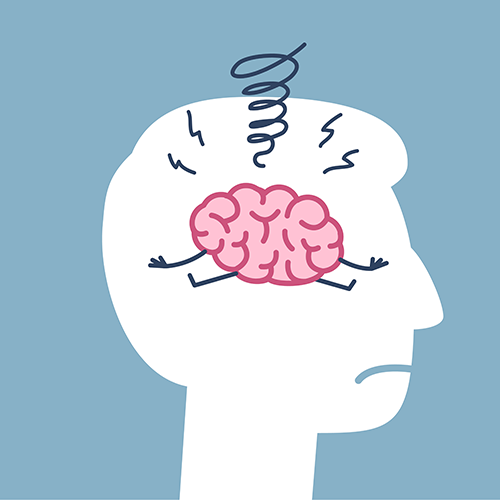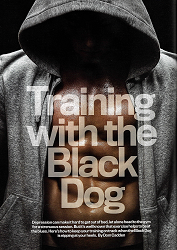The avalanche of studies, expert opinion and health guidelines leave little doubt: exercise helps lift your mood and the symptoms of depression. Great stuff, but the catch is that if you’re struggling with crappy mood, wimp-out energy and a lack of enthusiasm, then working out is the last thing you feel like doing.
Dom Cadden
On top of that, these studies and guidelines are usually directed to people who do little to no regular exercise, so doing anything at all makes a difference. So what’s the deal for those of us who already try to exercise regularly or train for a sport, but the Black Dog bites away at our best intentions to train and our hard-earned gains?
Depression can be like going along a potholed road in the dark – you spend some time on the level, then without warning, you clank down into a pit of despair and you’re thrown off course. Some days will be better than others. Other days, typical depressive symptoms take over. You’ve barely slept, you have the focus of a goldfish, you have a hard time motivating yourself to do anything that’s optional, let alone talking to people. You feel lethargic, your head’s fuzzy and maybe your confidence is shot, too. How can you keep on the straight and narrow to your training goals?
Treat exercise like a medication. That is, you don’t just do it a few days a week or whenever you feel like it, you do it on a daily basis, even if the dose varies – some days will be low intensity and more relaxed, other days you’ll hit it hard.
Frequency beats exercise type
I wish I could tell you that barbell curls will lift that black cloud, every time and for every person. It sucks it’s not true, because if it was, all of us who get depression could walk around quietly acknowledging each other’s mad biceps pump.
“The research does not favour one exercise modality over
another for managing depressive symptoms,” says Oscar Lederman, an exercise physiologist with the Prince of Wales
Hospital who is researching the role of exercise in the treatment mental
illness.
“However, the evidence suggests that those achieving the recommended physical
activity guidelines (150 minutes of moderate to vigorous physical activity per
week) will experience the greatest benefits,” he says.
A groundbreaking study published in JAMA Psychiatry in January (2019) turned it up a notch, suggesting that people prone to depression should treat exercise like a medication. That is, you don’t just do it a few days a week or whenever you feel like it, you do it on a daily basis, even if the dose varies – some days will be low intensity and more relaxed, other days you’ll hit it hard.
For this study, researchers at Massachusetts General Hospital used a “data science hack”, examining the genetic and health information for over 600,000 adults to prove that the ideal amount of exercise to prevent or ease depressive symptoms started at about 15 minutes of vigorous activity (e.g. running) each day, or lighter activity for an hour a day.
The problem many of us have is that we take an ‘all or nothing’ approach. “Rest days” truly become do-nothing days, sometimes because we’ve flogged ourselves into a state where we’re semi-comatose for the next couple days, or because we think if we can’t go hard, we won’t bother training at all.
On my ‘dark’ days, I often have a TED session – ‘train everything differently’. This also works well after illness or injury. It’s not about bludging. In fact, a good TED session is often still regimented and can be as tough as you want it to be.
Think about cycling the intensity of your training. A day off training might mean that “rest” is a yoga session, a brisk walk, or some easy cycling for 30 minutes, or maybe a quick swim.
“Positive reinforcement helps… I like to remind people that ‘something is better than nothing, and something more is better than something’,” Lederman says.
Make sure it’s all you
Let’s bite into some cold, hard truth: if you’re training for a sport or some other really specific purpose, you can’t always just do what you want – you have to do what you need. But in the big picture, are you doing something you enjoy?
Perhaps your idea of getting into shape was to hit up a trainer, who told you that you should have a goal, and that goal should be a half-marathon – and it turns out you hate running. Maybe your mate dragged you along to the gym to do weights, but six weeks on you despise those evil bollocks of metal as much you did on day one. In both cases, all the best-designed training programs in the world won’t help ease depression symptoms. “This is something I’ve noticed in clinical practise, but it’s also supported by the research – people are more likely to maintain physical activity long term when the motivation to exercise comes from within themselves,” Lederman says.

Have realistic, achievable goals
Depressive symptoms are often associated with a sense of aimlessness and low self-esteem. So having goals helps give you a purpose and positive reinforcement when they are achieved, but if you’re striking out too often, then your goals just bully you into a dark corner where you wonder why you bother. So set small, frequent and achievable goals. If you make your first target to exercise frequently for the good of your mental health, then that’s simply a matter of sticking to a training schedule. That’s something you can control. Knock that off and you’ll be on your way to your other training goals.
Plan for the dark days
On those days when nothing seems to lift your mood and there’s lead in your shoes,
acknowledge that it’s going to be harder for you to exercise than the next person.
The problem for many people is that they trap themselves with the ‘all or nothing’ approach. That is, if they think they won’t be able to train to the standard that they, they don’t train at all. I mean, why bother – right?
On days like these, I often have a TED session – train everything differently. This also works well after illness or injury. It’s not about bludging. In fact, a good TED session is often still regimented and can be as tough as you want it to be. The main point of TED days is to take the pressure off by doing something for which you have no or little comparative basis so you can’t judge yourself. For example, you could focus on time intervals instead of the amount of weight you lift or the total distance that you run.
“I really like the TED method as it touches on the idea of adapting programs to how someone is feeling on the day, Lederman says.
“Depression is not one constant state, and symptoms can fluctuate day to day. Allowing some flexibility in the program prevents perceived ‘failure’ and help maintain a routine.”

You might even do the same exercises in your scheduled routine, but with some little variations that mean you have no idea what you can or should do. Let’s say you usually do squats for sets of eight, you might instead do dumbbell jump squats for as many reps as you can in 30 seconds. You could run or cycle your usual route, but do it differently. For example, cut down to 70 per cent of the usual distance and go fast as you can for one minute, then go easy for four minutes.
On days when you’re really dragging yourself, go to town on the ‘different’ part of TED. Instead of squats, crank up the levels on a stationary cycle and go hard for 45 seconds, then easy for two minutes. Go run at a different location without knowing the distance – go run different terrain, like a beach or a bush track. Or forget the run and go shoot some hoops. There’s no right answer to what makes the right activity on these days, it’s whatever works for you.
“In my practise, I know some people who, when presenting quite depressed, will really benefit from exercises that are cognitively challenging or test co-ordination and balance,” Lederman says.
“For them, it may offer a distraction from there negative thoughts and emotions. For others, these activities may be too difficult to process.”
Lone wolf or run with the pack?
You’ll often hear that people prone to depression should exercise with a group or do a team sport so that activity becomes ‘socially stimulating’. While this works for many people, it’s not for everyone.
“Whether I encourage group activity or training alone is completely dependent on the individual,” Lederman says.
“For example, people experiencing depression may experience anxiety or have a low self-esteem, in which case the idea of group-based exercise may be a deterrent.”
So rather than talk about training with other people or not, I put it this way: avoid isolation.
Interact with the world. Training alone in a garage or at a 24-hour gym where no-one cares if you live or die just doesn’t match up.
When I was powerlifting, I usually trained alone and with no coaching until final prep before competitions. However, it helped a lot that I trained at a club where the staff and other powerlifters and gym rats knew me by name, I knew that they looked out for me, and they knew if I was missing training. Later when I switched to ultramarathon running, I knew that for me, it was better to be out training in wilderness or somewhere like a beach where I would get a fix of strong sunlight (it helps keep up levels of the mood-lifting hormone serotonin), see people and be stimulated. So even I didn’t feel like interacting much with people, it helped that I was still interacting with the world. Training alone in a garage or at a 24-hour gym where no-one cares if you live or die (just don’t make eye contact!) doesn’t match up, and using cardio machines at home or running around a deserted industrial estate on your own is a dead-set mood and motivation killer.
If you think training alone is better for you, it’s good to be accountable to someone. They don’t have to be a coach or trainer or even someone who does your activity. The important thing is that they understand your motives for your training and how important it is for you to do it, both for your goals and your general wellbeing. An app alone can’t handle this. You need that support network (even one person) who can give you an outsider’s perspective instead of just having the voices in your head mess with you.
Manage fatigue
Depression symptoms can be both a cause of and be exacerbated by poor sleep. At the same time, moderate to high intensity exercise can help you sleep better, but it also tends to make you need more sleep. So it’s a weird vicious circle that somehow also has a chicken and an egg chucked in at the same time.
America’s National Sleep Foundation warns that even small levels of sleep deprivation over time gnaw down your happiness and affect your mood and mental health. You can be less enthusiastic and more irritable, and people with clinical depression can see a flare-up of symptoms, such as feeling persistently sad or empty.
Allow for extra sleep after your harder training sessions and aim to catch up on lost sleep as soon as you can. Make an effort to improve the quality and consistency of your sleep just as much you’d try to improve your nutrition and training. Follow the standard health practitioner guidelines for improving sleep quality, such as a ‘wind down’ routine that reduces exposure to noise, lights, arguments, Facebook trolls and other strong stimulation a couple hours before sleep, avoid caffeine in the eight hours before bed, and wake up the same time every day.

Finally, remember that exercise itself is a self-management aid for depression, not a cure-all. If your depression is being treated by a health professional, keep him or her in the loop and don’t change or stop any existing treatment or medication without their advice.
Thanks to Exercise and Sports Science Australia.
This article originally appeared in Men’s Fitness magazine, May 2019





